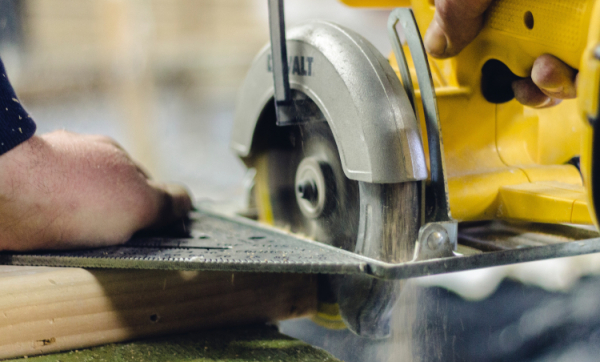MDF (medium-density fibreboard) is a great choice for low-budget DIY projects and home improvements. MDF has a smooth, ready-to-paint surface that gives it a high-end look and feel that DIY enthusiasts enjoy. The problem is that MDF is sometimes hard to cut. Here are cut and edge specialists, Cworkshop's tips on the right way to cut MDF panels.
So why is it so hard to cut MDF?
Even though you might be tempted to grab your hacksaw and depend solely on your DIY skills, you might end up worse off.
MDF is made up of hardwood and softwood shavings that have been turned into fibres. Because of this, it can be messy to cut the wood to the desired size. So you can say goodbye to the idea that you can make a straight, precise edge using inadequate tools.
First things first: Safety
Wear goggles and a dust mask. As your saw blade cuts through MDF, the teeth create wood dust. This dust may contain urea-formaldehyde (known to cause cancer) from the glue used to hold the wood shavings together. You don't want to breathe in the wood dust, so make sure you have the right safety gear on.
If you are concerned about wood with urea-formaldehyde, you can find medium density fibreboard with low chemical emissions. This is perfect for custom furniture in areas that are sensitive to the environment.
Which saw and why?
Using a Jigsaw: Perfect for shapes or thinner MDF
One way to cut MDF is to use a jigsaw - here's some tips on how to cut MDF, no matter what size it is.
1. Attach the right blade.
Attaching the right blade with TPI (teeth-per-inch) between 7 and 12 will reduce tear off and fibres. For rough cuts, a lower TPI range works well, but if you're looking for more precision, make sure to increase the TPI. A jigsaw with 12 TPI is perfect for making curved cuts in your sheet of MDF because the blade is thin enough to be moved around corners with a steady hand and patience.
2. Score a cut line.
You can also help yourself cut a panel by making a clear cut-line ahead of time. Using a utility knife to score a line on the surface where you want to cut will help you get a more accurate cut, even if it will never be perfect. You'll get a long way with a steady hand, good preparation, and the determination to get the edge sanded.
3. Secure your material.
Clamping your board to your work table will really help. If you don't have a sawhorse, it may be difficult to cut a large MDF board down the middle. You will have trouble if you try to cut a board that is too big for you to reach. Do not try to cut MDF beyond your reach.
Don't try to force the blade of your jigsaw through the board. If you put too much force on the blade, it will bend or break.
Using a Router: Perfect for odd shapes and slightly thicker MDF
When cutting custom edges, curves, and shapes out of MDF with a router, you'll still need to score a cut line, use the right blade, and secure your material well. For cutting MDF, use a carbide flute bit, which is strong enough to get through the material.
Even if you are the most dedicated DIYer, you probably won't get the most use out of a router over time. If you want to buy a router to cut MDF to the right size, it can cost quite a bit (not to mention the additional drilling parts).
Alternatively, you can use expert services for cut-to-size MDF such as the services offered by Cworkshop, you can save money on a tool you might only use once and avoid the stress of making a mistake.
Using a Circular saw: Perfect for MDF that is thicker
It's best to use a circular saw to cut a straight edge for professional joinery (depending on the size of your MDF board). When cutting MDF sheets with a circular saw, the advice mentioned still applies.
With a jigsaw, you must keep your hand steady to get a straight cut through the MDF sheet. With a circular saw however, you will always get a straight cut. If you use a circular saw to cut MDF, be careful as they tend to make a lot of dust. Find a circular saw with a vacuum system to avoid this as much as possible.
Using a Table Saw: Ideal for cutting straight, long MDF panels
The table saw is the king of power tools. Cutting MDF with a table saw will result in a more accurate cut as less of the edges will break off and splinter. If you need to cut a lot of MDF sheets, you will need a table saw. You can add a jig to the platform, which allows you to cut MDF panels accurately and the same way every time.
Should you cut MDF yourself?
If you know how to work with wood, have all the tools you need, enough time, and a steady hand, you can try your hand at your MDF board. Many of these specialised tools can be very expensive and even dangerous if they are used wrong or if you aren't paying attention.
It's a good idea to pay professionals to cut your MDF with the money you would have spent on the tools you need.
If you use a professional MDF cut-to-size service like Cworkshop's, you will not only save time and effort, but you can also be sure that the job is done right. Cworkshop cuts the MDF with CNC machines and computer-controlled panel cutting technology which are the best in the business.
